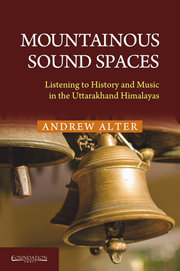Book contents
- Frontmatter
- Contents
- List of Figures
- List of Tables and Musical Examples
- Preface
- Acknowledgements
- Introduction
- 1 Echoes of Colonialism: Bagpipes in the Himalayas
- 2 Echoes of a Royal Heritage: Vestiges of Naubat
- 3 Possession and Performance: Sounding Out the Epic Worlds of Heroes and Gods
- 4 Worlds of Sound: Revisiting the Parameters of Oral Tradition
- 5 Flutes, Sprites and Mountainous Geographies
- 6 Drum Strokes, Syllables and Rhythmic Patterns
- 7 The Significance of Tantric Sects for Drum Practice in the Central Himalayas
- 8 Playing History: Sounding Out the Epic Worlds of Heroes and Gods
- 9 The Legacy of Garhwali Cassettes: Remembering the Pre-digital Age of Music Commodification
- Epilogue: Listening to an Uttarakhandi Himalayan Space
- Bibliography
- Index
2 - Echoes of a Royal Heritage: Vestiges of Naubat
Published online by Cambridge University Press: 05 October 2014
- Frontmatter
- Contents
- List of Figures
- List of Tables and Musical Examples
- Preface
- Acknowledgements
- Introduction
- 1 Echoes of Colonialism: Bagpipes in the Himalayas
- 2 Echoes of a Royal Heritage: Vestiges of Naubat
- 3 Possession and Performance: Sounding Out the Epic Worlds of Heroes and Gods
- 4 Worlds of Sound: Revisiting the Parameters of Oral Tradition
- 5 Flutes, Sprites and Mountainous Geographies
- 6 Drum Strokes, Syllables and Rhythmic Patterns
- 7 The Significance of Tantric Sects for Drum Practice in the Central Himalayas
- 8 Playing History: Sounding Out the Epic Worlds of Heroes and Gods
- 9 The Legacy of Garhwali Cassettes: Remembering the Pre-digital Age of Music Commodification
- Epilogue: Listening to an Uttarakhandi Himalayan Space
- Bibliography
- Index
Summary
In an old book on the history of Garhwal written by Harikrishna Raturi, the author presents extensive lists of the various caste names of families in Garhwal. The book was originally published in 1928 during the days of the Garhwali Raja and would seem to present a first-hand account of practices from that time. Within his list of untouchable castes, Raturi (1988 [1928]: 90) lists ‘aṭpahariyā’ and describes these as: ‘nakarāchīs [players of the naqqara drums] who used to sound out the eight times of day on the naubat in the naubatkhānā of the court', Very few present-day musicians play these kinds of drums though drummers regularly refer back to a shared memory of court drumming. Raturi's statement is significant because it is one of the few sources from the time that mentions musical activity in the Garhwali rājā's court.
As the previous chapter illustrates, musical instruments as well as their combinations within specific ensembles are frequently associated with political power and military conquest. While instruments may hold a variety of symbolic meanings in different contexts, their use as sonic expressions of power may be heard in numerous musical traditions throughout the world. The adoption of the bagpipe into village-level musical practice as well as that of the Garhwal and Gorkha Regiments of the Indian Army enmeshes a complex history of imperial power within local sonic expressions of regional identity.
- Type
- Chapter
- Information
- Mountainous Sound SpacesListening to History and Music in the Uttarakhand Himalayas, pp. 17 - 28Publisher: Foundation BooksPrint publication year: 2014

